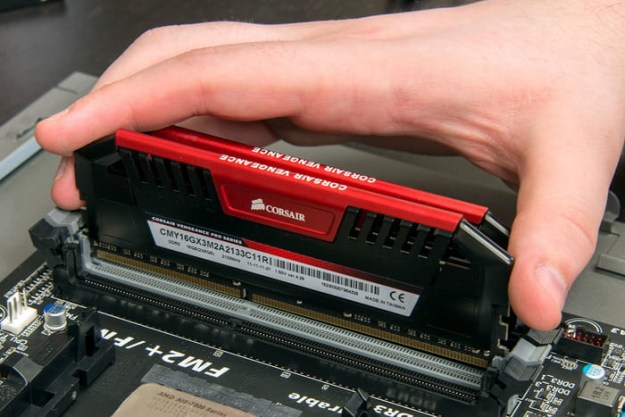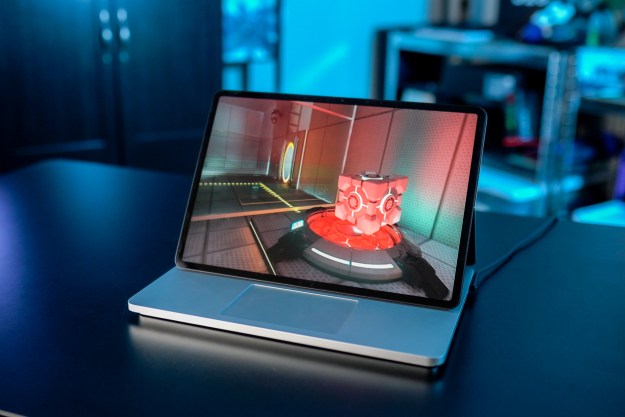“HP’s latest all-in-one touchscreen PC, the TouchSmart 600-1055, boasts impressive upgrades to both form and function.”
- Huge, gorgeous, 16:9 1080p screen.
- TouchSmart suite delivers some excellent programs.
- Svelte and attractive design.
- Doubles nicely as a PVR/TV, complete with HDMI input for game consoles.
- Touchscreen is still just a smidge finicky.
- Middling processor and graphics card could do with an upgrade.
- It’s still a bit costly.

Introduction
HP’s top-of-the-line third-generation TouchSmart touchscreen PC should keep the line front and center for consumers looking for an all-in-one running a Microsoft operating system. Its sharp design, surprising utility, and inspired suite of touchscreen applications makes it an ideal choice for any family looking to place a stylish computer in a common area.
 Features and Design
Features and Design
From an aesthetic standpoint, each new TouchSmart model seems to be just a little slicker looking than the last, and the TouchSmart 600-1055 is no exception.
Its thin piano black bezel rests on three legs; a pair of u-shaped supports in the front and a photo frame-inspired kickstand in the back. A recessed blue light, the intensity of which can be altered via a button on the side of the display, shines down on a super-slim wireless keyboard and matching mouse, both of which can be slid under the display and out of sight when not in use, ensuring that the machine maintains a relatively small footprint.
In most home use scenarios only a single cord—for power—will trail out from behind the computer. There are, however, plenty of ports that provide for connection to a wide range of devices, including a coaxial input for television, five USB jacks, a six-in-one memory card reader, headphone and mic ports, an HDMI jack to let the kids hook up their PlayStation 3 and Xbox 360 consoles, and several additional audio/video inputs and outputs to allow users to connect other video playback devices and speakers.
Long story short, it’s a fully-functional and mighty pretty all-in-one PC system that consumers can proudly display anywhere from the kitchen counter to the living room sideboard.
Software
The TouchSmart 600’s design is sexy, no question, but even more important than the hardware is the software.
Since the beginning, HP has marketed the TouchSmart line based on its titular suite of simple and intuitive applications, and the company’s latest version of the program offers the best, most well-rounded selection of apps yet.
If you’re unfamiliar with TouchSmart, you can think of it as a second, simpler operating system that provides bigger buttons better suited for a touchscreen interface and gives people easy access to many commonly used applications. The version running on HP’s latest generation machines has been revamped for Microsoft’s Windows 7 OS, which itself has been retooled to work seamlessly with touch-enabled screens.

There are TouchSmart programs that let users browse music, videos, and pictures (you can spread images out and then stack them, tag them, or change their size in a way that vaguely recalls Tom Cruise interacting with his open air computer in Minority Report); create voice, video and written messages for family members that appear as sticky notes on the screen; and keep calendars of events that can be shared and printed as needed. It’s a great group of programs for busy families.
There are also tiles for television viewing and movie playback. Connect your cable signal to the built-in tuner card and you’ll be able to play, pause, rewind, and record live television shows via TouchSmart’s simple but effective Live TV program. Or you can just pop in a DVD or Blu-ray disc. TouchSmart apps also exist for the online video services Hulu and Netflix. Regardless of the content source, you can control the action with not only touchscreen buttons but also a full-sized media remote that comes in the box. Indeed, few other computers feel so at home (or perform as admirably) doubling as a television.
On the Web side, you can record videos using the tilting webcam above the screen and then upload them to YouTube at the tap of a button. You can also launch Internet Explorer 8, keep an eye on your Twitter feed, and set up RSS feeds.
Another neat app is Recipe Box, a program for chefs that grabs and formats recipes from the Web. It can respond to voice commands and read cooking directions out loud, helping ensure you don’t grease up the screen while preparing meals.
While there is certainly room for more TouchSmart apps (where’s Facebook?), those HP has provided are well-designed and useful. Plus, users can always create their own customized TouchSmart tiles for any website they choose (though websites generally aren’t designed for touchscreen interface).
Our only real beef is that the touch interface is still just a smidge finicky. It sometimes registers a tap when your finger is hovering just above the screen, and slow brushes are sometimes picked up as quick flips (we noticed that even the woman in the video meant to demonstrate the interface wasn’t always able to flip through apps with perfect smoothness). Still, it’s a minor issue.
 Performance
Performance
If there’s one place HP’s newest all-in-one lets users down, it’s in the horsepower department. The unit we reviewed, which was top of the line, had an Intel Core2 Duo processor, 4GB of DDR3 RAM, and an NVIDIA GeForce GT230M graphics card with 1GB of dedicated memory. These components are fine for multitasking with office applications and working with HD video, and they even suffice for running the occasional 3D game, but there are cheaper laptops out there that boast more powerful graphics cards and speedy quad core processors. Something about that just seems a bit odd to us.
Of course, none of them can match this rig’s stunning, 23-inch, 1080p, 16:9 aspect ratio, touch-enabled glossy screen. It takes up a pretty big chunk of your field of vision when standing or sitting in front of it, and it delivers crisp colors and terrific clarity. It’s a terrific display for just about anything you care to put on it, be it pictures, movies, documents, or games. It’s a beauty that raises the bar for consumer screens in this category.
Conclusion
With all-in-one touchscreen PCs becoming less expensive all the time—you can now find one for as little as $500-$600 at major retailers—the $1,519 TouchSmart 600-1055 might seem a bit pricey. Keep in mind, though, that HP’s machine is offering an enormous and unparalleled touch display, a terrific suite of useful, intuitive, touch-enabled software, and industrial design that’s both beautiful and clever. The moral of the story: If you want the best, sometimes you have to pay of its company.
Highs:
- Huge, gorgeous, 16:9 1080p screen
- TouchSmart suite delivers some excellent programs
- Svelte and attractive design
- Doubles nicely as a PVR/TV, complete with HDMI input for game consoles
Lows:
- Touchscreen is still just a smidge finicky
- Middling processor and graphics card could do with an upgrade
- It’s still a bit costly
Editors' Recommendations
- HP unveils new IPS Black monitor with one key new feature
- HP launches a work-from-home PC to take on the new iMac






